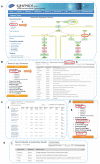KANPHOS: A Database of Kinase-Associated Neural Protein Phosphorylation in the Brain
- PMID: 35011609
- PMCID: PMC8750479
- DOI: 10.3390/cells11010047
KANPHOS: A Database of Kinase-Associated Neural Protein Phosphorylation in the Brain
Abstract
Protein phosphorylation plays critical roles in a variety of intracellular signaling pathways and physiological functions that are controlled by neurotransmitters and neuromodulators in the brain. Dysregulation of these signaling pathways has been implicated in neurodevelopmental disorders, including autism spectrum disorder, attention deficit hyperactivity disorder and schizophrenia. While recent advances in mass spectrometry-based proteomics have allowed us to identify approximately 280,000 phosphorylation sites, it remains largely unknown which sites are phosphorylated by which kinases. To overcome this issue, previously, we developed methods for comprehensive screening of the target substrates of given kinases, such as PKA and Rho-kinase, upon stimulation by extracellular signals and identified many candidate substrates for specific kinases and their phosphorylation sites. Here, we developed a novel online database to provide information about the phosphorylation signals identified by our methods, as well as those previously reported in the literature. The "KANPHOS" (Kinase-Associated Neural Phospho-Signaling) database and its web portal were built based on a next-generation XooNIps neuroinformatics tool. To explore the functionality of the KANPHOS database, we obtained phosphoproteomics data for adenosine-A2A-receptor signaling and its downstream MAPK-mediated signaling in the striatum/nucleus accumbens, registered them in KANPHOS, and analyzed the related pathways.
Keywords: KANPHOS; adenosine signaling; intellectual disability; molecular mechanism; neurodevelopmental disorders; phosphoproteomics; phosphorylation; signal transduction.
Conflict of interest statement
The authors declare no conflict of interest.
Figures







Similar articles
-
KANPHOS: Kinase-associated neural phospho-signaling database for data-driven research.Front Mol Neurosci. 2024 Apr 2;17:1379089. doi: 10.3389/fnmol.2024.1379089. eCollection 2024. Front Mol Neurosci. 2024. PMID: 38628370 Free PMC article.
-
In Vivo Identification of Protein Kinase Substrates by Kinase-Oriented Substrate Screening (KIOSS).Curr Protoc Chem Biol. 2019 Mar;11(1):e60. doi: 10.1002/cpch.60. Epub 2019 Jan 7. Curr Protoc Chem Biol. 2019. PMID: 30615307
-
Unraveling Kinase Activation Dynamics Using Kinase-Substrate Relationships from Temporal Large-Scale Phosphoproteomics Studies.PLoS One. 2016 Jun 23;11(6):e0157763. doi: 10.1371/journal.pone.0157763. eCollection 2016. PLoS One. 2016. PMID: 27336693 Free PMC article.
-
Phosphorylation Signals Downstream of Dopamine Receptors in Emotional Behaviors: Association with Preference and Avoidance.Int J Mol Sci. 2022 Oct 1;23(19):11643. doi: 10.3390/ijms231911643. Int J Mol Sci. 2022. PMID: 36232945 Free PMC article. Review.
-
From Phosphosites to Kinases.Methods Mol Biol. 2016;1355:307-21. doi: 10.1007/978-1-4939-3049-4_21. Methods Mol Biol. 2016. PMID: 26584935 Review.
Cited by
-
Rho-Kinase/ROCK Phosphorylates PSD-93 Downstream of NMDARs to Orchestrate Synaptic Plasticity.Int J Mol Sci. 2022 Dec 26;24(1):404. doi: 10.3390/ijms24010404. Int J Mol Sci. 2022. PMID: 36613848 Free PMC article.
-
Rho-Rho-Kinase Regulates Ras-ERK Signaling Through SynGAP1 for Dendritic Spine Morphology.Neurochem Res. 2022 Sep;47(9):2757-2772. doi: 10.1007/s11064-022-03623-y. Epub 2022 May 27. Neurochem Res. 2022. PMID: 35624196
-
KANPHOS: Kinase-associated neural phospho-signaling database for data-driven research.Front Mol Neurosci. 2024 Apr 2;17:1379089. doi: 10.3389/fnmol.2024.1379089. eCollection 2024. Front Mol Neurosci. 2024. PMID: 38628370 Free PMC article.
-
Neuromodulator regulation and emotions: insights from the crosstalk of cell signaling.Front Mol Neurosci. 2024 Mar 7;17:1376762. doi: 10.3389/fnmol.2024.1376762. eCollection 2024. Front Mol Neurosci. 2024. PMID: 38516040 Free PMC article. Review.
-
Multi-omics analysis of diabetic cardiomyopathy pathogenesis using a type 2 diabetic Zucker diabetic fatty rat model.Sci Rep. 2025 Jul 2;15(1):22797. doi: 10.1038/s41598-025-04670-5. Sci Rep. 2025. PMID: 40595975 Free PMC article.
References
Publication types
MeSH terms
Substances
Grants and funding
- JP18dm0207005, JP21dm0207075, JP21wm0425017 and JP21wm0425008/Japan Agency for Medical Research and Development
- JP16K18393, JP17H01380, JP17K07383, JP17H02220, JP17K19483, JP18K14849, JP19K16370, JP21K06428 and JP21K06427/Japan Society for the Promotion of Science
- JP17H05561, JP19H05209 and JP21H00196/Ministry of Education, Culture, Sports, Science and Technology
LinkOut - more resources
Full Text Sources

